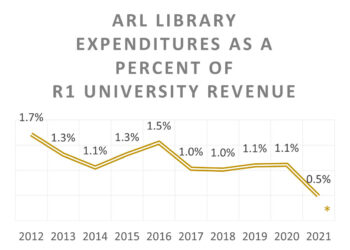Shortly after the White House Office of Science and Technology Policy (OSTP) released its memo regarding public access to federally funded research in February 2013, The Clearinghouse for the Open Research of the United States (CHORUS) was born. This publisher-driven initiative was one of a few that took on the charge of responding to the requirements detailed in the OSTP memo.

The development of CHORUS has moved very swiftly, in publishing terms, and relies heavily on existing infrastructure as well as new tools that were already in development. A few weeks back, CHORUS released their CHORUS Publisher Implementation Guide and held workshops and spoke at several recent industry conferences.
The implementation is not without complications. Publishers need to make some pretty serious decisions on how to proceed. The biggest decision may be exactly what to expose in order to comply with any forthcoming public access mandates. The options are to make the accepted manuscripts (AM) publicly available for papers derived from federal funds or to allow access to the final PDF or version of record (VoR). Either is acceptable under federal requirements.
The next single most important question may be whether to impose an embargo and the duration of the embargo period. The OSTP memo allowed for embargo periods of up to 12 months but with consideration for longer embargoes for fields that may support it. In the end, the question of embargo periods may be moot as the agencies are likely to set maximums as part of their public access policies. Publishers could choose to implement a shorter time period or no time period at all, but 12 months seems to be the likely default, at least as things start.
Before we look at what publishers will provide, let’s remember that public access is not the same as open access. Under the guidelines laid out in the OSTP memo, the federal government is not offering to pay article processing fees in order to make papers open access. What the memo asks is that “any results published in peer-reviewed scholarly publications that are based on research that directly arises from Federal funds” be made publicly available.
One could argue that a separate report on the results would suffice in meeting this requirement but this seems like a lot of redundant work for the researchers when they already have a published research paper. Papers that are made available to the public under forthcoming mandates would not necessarily be considered open access. The publisher may still retain copyright of the published PDF and the publisher may be counting on subscription revenue to offset the expense of peer-review management, copyediting, typesetting, hosting, distributing, etc.
What CHORUS is building is a portal to papers derived from federally funded research that allows content to remain on the publishers online platforms. The infrastructure depends heavily on CrossRef deposits that must include FundRef metadata.
Within the CHORUS framework, and really any mandated delivery model, publishers may choose to only expose the AM, essentially a PDF of the author’s final manuscript with no proofing, editing, tagging, typesetting, etc. The CHORUS Implementation Guide lays out the technical options for this but does not offer much advice to publishers, nor should it. In order to explore the options, I interviewed by email two individuals whose organizations are participating in the CHORUS pilot. One organization has made the decision to expose the VoR and the other has yet to make a final decision but went with AM for the pilot.
Exposing the Accepted Manuscript
The American Physical Society (APS) is one of the publishers participating in the CHORUS pilot. Mark Doyle, Director of Journal Information Systems and Chair of the CHORUS Technical Working Group, explained why APS chose to expose the AM for the pilot.
“The OSTP memorandum specifies the AM as the minimal requirement to meet the goals of the policy. So for the purposes of the pilot we felt it was best to demonstrate the most conservative path toward fulfilling the OSTP requirements. We also wanted to avoid the appearance of ‘bait and switch’ if we were to use the VoR in the pilot, but then ultimately were to settle on the AM,” Doyle wrote in email correspondence. APS has decided that they will continue to expose the AM as part of the live protocol for CHORUS.
The choice to expose the AM is a choice to expose an inferior product to the one being sold by a publisher. Some researchers debate the value being added by the publishers but the customers speak volumes. Just think back to the dust up over publishers sending takedown notices to websites hosting final PDFs. Authors insisted that only the final published version would do for posting.
The quality of the AM will likely vary by field. Authors in physics have a tradition of making pre-prints of the AM available in the arXiv repository. Physics authors take great care in producing a high-quality manuscript. Authors in this area also tend to use REVTex, which is much more sophisticated in its manuscript layout options. Authors in other fields may not be so meticulous and the manuscripts may be full of typos, double-spaced, have figures and tables at the end, and references that don’t link. Perhaps the proliferation of AMs will increase the quality of the final manuscripts submitted to journals.
“We do… feel strongly that the VoR is more valuable than the AM,” wrote Doyle. But, Doyle added that APS included 12,000 articles in the pilot program and only one author complained about the AM being exposed. In fact, in a survey of authors done by Taylor & Francis recently, about 45% of respondents said that AMs found in a repository were “just as useful” as the VoR.
Some journal readers and authors have also argued that no one will know how to cite a paper when access is restricted to the AM. At a minimum, readers have access to the metadata for an article, which provides all of the information needed to properly cite a paper. APS also addressed this issue by placing a cover sheet on each AM with citation information and has also suppressed the AM version from Google and Google Scholar indexing.
There cannot be an expectation that publishers make a paper look good (at a cost) and then give it away. For many publishers, this is not a business model that works. Hence, exposing the AM in the face of pending public access mandates may make a lot of sense—for publishers (and in this case, the publishers get to decide).
Exposing the Version of Record
There are some other concerns with exposing the AM. Some have argued that it doesn’t represent the best of the journal. This again speaks to the question of the value added to the VoR.
“Of course everyone would like to make the VoR freely available immediately upon publication (something we [APS] actually allow our authors to do on their own web sites and their institutional ones!); however, there are economic consequences to doing this systematically and thus there are tradeoffs to be made” wrote Doyle.
Oxford University Press (OUP) has decided to expose the VoR for papers resulting from Federal funding.
“We wish to provide readers with the best, highest-quality information that we can. Our mission, as a department of the University of Oxford, is to further the University’s objectives of excellence in scholarship, research, and education. Allowing access to the VoR on our sites through CHORUS helps us fulfill that mission by offering a professionally reviewed, edited and typeset version of the article in the format that we believe most readers prefer,” wrote David Crotty, Senior Editor at OUP and CHORUS Board Member (full disclosure, also the Executive Editor of The Scholarly Kitchen), in an email response to questions.
Exposing the VoR also ensures that all readers are accessing the most recent version of a manuscript.
“Unlike the AM, the VoR will contain any subsequent corrections, changes or updates that are made to the article throughout its post-publication life,” wrote Crotty. This is an important consideration. Most university repositories claim no responsibility for correcting the literature. I ask this question all the time and the answer is always the same—there are no resources for tracking corrections and updating records.
That said, unless a publisher is using CrossMark on the VoR to alert those who have saved a paper to their own devices that a change was made, the user of the VoR is no more likely to find corrections than the user of an AM. All links and notices of corrections to a paper should be available on the abstract page of that paper, which will be a shared page for the VoR and the AM. This is a benefit to using CHORUS and a strong argument for keeping papers on the publisher sites. Once a manuscript gets posted in a separate repository, links to any subsequent corrections are lost.
Exposing the VoR may be easy for publishers of medical journals who may already make the VoR open after a 6-12 month embargo period. However, “it is very unclear how a 12 month embargo would impact journals in other subject areas (e.g humanities, social sciences, mathematics), and our policies in those areas will continue to develop over time,” Crotty wrote.
Doyle added, “There is no precedent within physics (and closely related physical sciences) of making VoR’s freely available after only one year, in contrast to the biomedical community. At this point, we do not feel that we understand well enough the impact one year embargoes might have on our subscriptions.” This is an important statement given that a lot of physics material is posted in arXiv. Several publishers in other areas of the physical sciences have advocated for 18-24 month embargoes citing the potential loss of revenue in fields where the “hot off the press” articles are not as valuable to the users as a paper that has some sticking power to it.
It is unclear when agencies will announce policies and what those policies will entail. In the meantime, publishers would be wise to start discussing the options internally and with their platform providers. Participating in CHORUS is one option for publishers but the agencies may decide to require a completely different infrastructure. With any luck, the government will be generous with an implementation deadline.
Discussion
21 Thoughts on "Implementing CHORUS: Big Decisions Loom for Publishers"
I wonder if embargoes could sustain a court challenge. The underlying concept being that taxpayer funded works are, by definition, in the public domain. Certainly, this applies unambiguously to the AM but what of the VoR? Would the differences between AM and VoR have to be of a certain order and magnitude to justify treating the VoR as if it were proprietary – even if only temporarily so?
Why would the AM be in the public domain? Grant recipients are not considered employees of the US government, and under the Bayh-Dole Act, all intellectual property generated belongs to the researcher and their institution.
Taxpayer-funded works are not, by definition, in the public domain. That’s only true of governments documents — works created by government employees in their capacity as government employees. Being the recipient of a federal grant doesn’t make you a federal employee.
Indeed, at this point the US Government is only claiming a “federal use” right to the AM. Interestingly, this seems to mean that no one can claim a more restrictive copyright to the AM that the government makes public, neither author nor publisher. But what is allowed under federal use is far from clear. Another possible legal swamp looms.
Most of the journal articles in question are not taxpayer funded. They are written long after the grant contract is closed out, hence not billed to the grant. So the interesting legal question is how the government gets any right to them? I am told by legal experts that there is some kind of unwritten rule in play here but that is certainly strange law if true.
This editorial has just been flagged in an Australian primary care research newsletter:
Woolley, Karen L., Gertel, Art, Hamilton, Cindy, Jacobs, Adam, & Snyder, Gene. (2012). Poor compliance with reporting research results – we know it’s a problem … how do we fix it? Current Medical Research and Opinion, 28(11), 1857-1860. doi:10.1185/03007995.2012.739152
http://informahealthcare.com/action/showCitFormats?doi=10.1185%2F03007995.2012.739152
Two quotes stood out for me:
“Thus, researchers would need to allocate an extra 25–60 hours for every study just to complete their clinical trial results posting requirements…” [on clinicaltrials.gov].
and…
“Considerable time is also required to prepare a manuscript for publication; the average time for manuscript preparation, including review cycles, is 7 months.”
The Bayh–Dole Act or Patent and Trademark Law Amendments Act (Pub. L. 96-517, December 12, 1980) clearly applies to patents and trademarks. How does this extend to copyright?
With regard to copyright, the contract can retain rights, including data (see FAR and DFARS at http://www.cendi.gov/publications/04-8copyright.html#41).
Regardless, federal grants do not require all writings created by funded researchers (which would include correspondence and laboratory notes presumably) to be placed in the public domain. Unless you’ve heard news that federal funding agencies are summarily changing the nature of their grant agreements, I assume this will remain the case.
But again, the FAR rights only extend to data documents created under contract. Many, probably most, journal articles are written after the contract closes out. This is because one does not write the article until the research is done and that is when the contract ends. The FAR requires a final technical report and that the government clearly owns. The post contract articles not so much. Some articles are only submitted a year or more after the contract ends.
CHORUS is a Trojan Horse, designed so that publishers retain control over the timing, terms and territory of any transition to Open Access. Think about it. http://j.mp/TrojanHorseChorus
Nonsense! It is the Feds that are asserting control via the US Public Access program. CHORUS is an attempt to minimize the damage that more Federal repositories like PMC will cause. CHORUS will improve scientific communication while reducing Federal expenses. It is an elegant solution to a difficult problem.
The Feds are (rightly) asserting control over the research output that the public funds by mandating public access to it. Doesn’t sound like nonsense to me. (Some) publishers are trying to slow the provision of public access to publicly funded research (by embargoing it) and are angling to remain the ones who provide the access, so that they retain control and proprietorship over both the research output and the provision of access to it. That doesn’t sound like nonsense to me either — just self-interest in a profound conflict of interest between those who fund, conduct and provide the research output (the Feds, the public, and researchers) on the one hand, and those who manage the peer review of that research output (publishers). The peers (researchers) review for free. It is not nonsense to attempt to hold onto a cushy deal for as long as possible. The Feds, the public, and researchers can only hope that that attempt will fail. And it will, though perhaps not until after another round of delay tactics, of which CHORUS and the lobbying for it are a prominent instance.
There must be a significant cost to posting and maintaining two different versions on one’s website. Has anyone looked at this? It seems like an awkward situation.
The costs and efforts really depend on the individual publisher’s platform, but yes, that is a consideration one must make in implementing CHORUS.
Yes, it will surely increase the costs. Certainly if you are on a commercial platform, there may need to be changes in order to implement this without duplicating metadata records. There would also be an expense if the publisher wants to amend the AM. For example, it would make sense to include the proper citation and potentially add a note that the paper has not been copyedited. This is not hard to do but it would need to be an added step for the compositor. As David C points out, the expenses are dependent on the platform and workflow of each publisher.
It is a very publisher-specific question. At APS, we maintain our own peer review system and journal platform, so the cost (effort) is minimal for us.To do the 12,000 pilot articles took several days of work. Most of the work was cleaning up the ms to programmatically remove watermarks and manuscript tracking codes (which we no longer add into the ms, so not a problem going forward) and adding the cover page. For production, there are additional steps of automation needed to populate the AM into our journal platform storage system – a few days of development time.
I listened to a CHORUS Publisher Implementation webinar recently and it seemed that at least some of the pilot publishers would, in effect, be allowing the DOI to direct you to either the VoR or the AM, depending on subscription status. It seemed to me that there’s a hornet’s nest of issues in allowing the DOI to effectively identify two different versions of the article. Anyone else agree?
Don’t most journal article DOI’s resolve to the article’s Abstract page? From there, the reader gets a choice of multiple versions, Abstract, Full Text HTML, Full Text PDF, and one would assume for publishers choosing the AM, that would be available as well. Is this really that big of a departure?
Heather, I would rather say, more broadly, that there is a hornet’s nest of issues with publishing two versions. Especially given that the US Feds might choose not to link to the AM version, since they may well be collecting them from the authors anyway. If they do that then making the AM accessible amounts to opting out of the US Public Access program.



